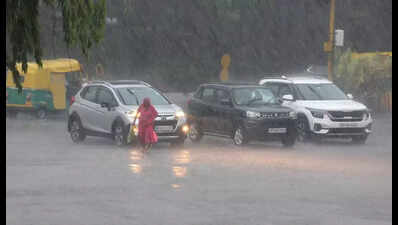Dehradun: A study published in Nature's ‘Climate and Atmospheric Science' journal recently has uncovered a critical flaw in global climate models (GCMs): These consistently underpredict Indian summer monsoon rainfall. Researchers at the University of Science and Technology of China and their collaborators traced this error to excessive light rain over the equatorial Indian Ocean (EIO), which sets off a chain reaction that blocks moisture transport to northern India, resulting in a persistent "dry bias" in monsoon forecasts.
This discovery could reshape how scientists model the South Asian summer monsoon—one of the world's most vital weather systems. It delivers 70–80% of India's annual rainfall, profoundly impacting food and economic security of over a billion people. Yet, GCMs typically underestimate monsoon rainfall over northern India by 10–20%, raising concerns about flood forecasting and long-term climate projections.
The study found that models overestimate light rain over the EIO, which enhances latent heat release and triggers stronger rainfall in the region. This, in turn, fuels an anomalous Hadley-type circulation -- a large-scale tropical pattern where warm air rises at the equator and descends in the subtropics. The descending branch of this circulation suppresses vertical motion over northern India, reducing cloud formation and moisture transport.
To investigate the flaw, the researchers ran numerical simulations during the active monsoon period in 2020 using two model resolutions -- a coarser 60 km model (U60 km) and a high-resolution 3 km model (U3 km). A 60 km resolution refers to the horizontal spacing between grid points in the model, meaning each grid cell covers a larger area and captures fewer localised details.
The researchers observed that the U60 km model exhibited a pronounced dry bias, underpredicting rainfall over northern India by 15% and overestimating EIO drizzle by 30%. In contrast, the finer U3 km model reduced the dry bias by 8% and cut excessive equatorial rain by 12%, improving accuracy. It also better captured monsoon dynamics, particularly the Somali jet, a key wind current that carries moisture from the Arabian Sea to India. In the coarser model, the jet's wind speed was 18% weaker than observed, while the high-resolution version closely matched reanalysis data.
The findings underscore the limitations of convection schemes in coarser GCMs, which regulate how clouds and rainfall are simulated. These schemes often overestimate the frequency of light rain, especially over the EIO, where it occurs 25% more often than in real-world observations. This bias shifts the rainfall distribution toward drizzle, intensifying the EIO rainbelt while reducing rainfall over northern India.
The researchers suggest that adjusting entrainment rates -- the rate at which environmental air mixes into rising convective clouds -- could help address this bias. The implications are significant for India, where monsoon variability affects food production, hydropower and flood preparedness. Underpredicting rainfall can hamper disaster response, while overestimating equatorial rain can distort climate projections.
"This study shows we need to rethink how models handle light rain," said lead author Gudongze Li. "Better convection schemes could transform our ability to predict the monsoon."
Dehradun: A study published in Nature's ‘Climate and Atmospheric Science' journal recently has uncovered a critical flaw in global climate models (GCMs): These consistently underpredict Indian summer monsoon rainfall. Researchers at the University of Science and Technology of China and their collaborators traced this error to excessive light rain over the equatorial Indian Ocean (EIO), which sets off a chain reaction that blocks moisture transport to northern India, resulting in a persistent "dry bias" in monsoon forecasts.
This discovery could reshape how scientists model the South Asian summer monsoon—one of the world's most vital weather systems. It delivers 70–80% of India's annual rainfall, profoundly impacting food and economic security of over a billion people. Yet, GCMs typically underestimate monsoon rainfall over northern India by 10–20%, raising concerns about flood forecasting and long-term climate projections.
The study found that models overestimate light rain over the EIO, which enhances latent heat release and triggers stronger rainfall in the region. This, in turn, fuels an anomalous Hadley-type circulation -- a large-scale tropical pattern where warm air rises at the equator and descends in the subtropics. The descending branch of this circulation suppresses vertical motion over northern India, reducing cloud formation and moisture transport.
To investigate the flaw, the researchers ran numerical simulations during the active monsoon period in 2020 using two model resolutions -- a coarser 60 km model (U60 km) and a high-resolution 3 km model (U3 km). A 60 km resolution refers to the horizontal spacing between grid points in the model, meaning each grid cell covers a larger area and captures fewer localised details.
The researchers observed that the U60 km model exhibited a pronounced dry bias, underpredicting rainfall over northern India by 15% and overestimating EIO drizzle by 30%. In contrast, the finer U3 km model reduced the dry bias by 8% and cut excessive equatorial rain by 12%, improving accuracy. It also better captured monsoon dynamics, particularly the Somali jet, a key wind current that carries moisture from the Arabian Sea to India. In the coarser model, the jet's wind speed was 18% weaker than observed, while the high-resolution version closely matched reanalysis data.
The findings underscore the limitations of convection schemes in coarser GCMs, which regulate how clouds and rainfall are simulated. These schemes often overestimate the frequency of light rain, especially over the EIO, where it occurs 25% more often than in real-world observations. This bias shifts the rainfall distribution toward drizzle, intensifying the EIO rainbelt while reducing rainfall over northern India.
The researchers suggest that adjusting entrainment rates -- the rate at which environmental air mixes into rising convective clouds -- could help address this bias. The implications are significant for India, where monsoon variability affects food production, hydropower and flood preparedness. Underpredicting rainfall can hamper disaster response, while overestimating equatorial rain can distort climate projections.
"This study shows we need to rethink how models handle light rain," said lead author Gudongze Li. "Better convection schemes could transform our ability to predict the monsoon."










